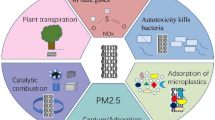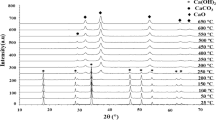Abstract
Radioactive iodine element mainly in CH3I is a key fission product of concern in the nuclear fuel cycle, which directly threatens human health if released into the environment. Effective capture of the I element is essential for human health protection. The iodine filter, consisting of an activated carbon inner core and cotton filter, is the most common radioactive iodine protection product. Currently, the activated carbon inside the iodine filter suffers from the weak adsorption efficiency and high cost. Herein, a process based on a strong alkali activation method was developed to significantly improve iodine absorption and reduce the cost. A series of flexible porous carbon fibers with a high specific surface area (up to about 1,500 ~ 2,200 m2/g) were prepared by carbonation of the phenolic resin fibers (PF, prepared through melt spinning and crosslink) followed by activation via KOH treatment. Meanwhile, the nitrogen-doped sp2-heterogeneous carbon atoms were prepared by adding nitrogen sources such as urea which led to a high surface area nano-porous fibers with an average pore size of ~ 2.4 nm. The nitrogen-doped porous carbon fibers exhibit very high adsorption for liquid iodine and iodine vapor. The liquid iodine adsorption capacity of nitrogen-doped porous carbon NDAC-4 prepared under 800 °C reaches 2,120 mg/g, which is 2.1 times higher than that of the commercial iodine filter, and for iodine vapor the capacity can reach 5,330 mg/g. Meanwhile, the CH3I adsorption capacity is 510 mg/g, which is 3.4 times higher than that of commercial unmodified viscose fibers and has greater stability and circularity. Importantly, the research has met the requirements of industrial production, and the fabrication of phenolic-fibers-based protection equipment can be widely used in the nuclear radiation industry.
Graphical Abstract







Similar content being viewed by others
Data availability
The datasets generated during and analyzed during the current study are available from the corresponding author on reasonable request.
References
Joffrey H, Andrey R, Habiba N, Virginie L, Grégoire A, Jean DT. Porous sorbents for the capture of radioactive iodine compounds: a review. RSC Adv. 2018;8:29248–73.
Ota M, Terada H, Hasegawa H, Kakiuchi H. Processes affecting land-surface dynamics of 129I impacted by atmospheric 129I releases from a spent nuclear fuel reprocessing plant. Sci Total Environ. 2020;704: 135319.
Lin H, Chebbi M, Monsanglant-Louvet C, Marcillaud B, Roynette A, Doizi D, Parent P, Laffon C, Grauby O, Ferry D. KI and TEDA influences towards the retention of radiotoxic CH3I by activated carbons. J Hazard Mater. 2022;431: 128548.
Banerjee D, Chen XY, Lobanov S, Plonka AM, Chan XJ, Daly JA, Kim T, Thallapally PK, Parise JB. Iodine adsorption in metal organic frameworks in the presence of humidity. ACS Appl Mater Interfaces. 2018;10:10622–5.
Yoshida N, Kanda J. Tracking the fukushima radionuclides. Science. 2012;336:1115–6.
González-García C, González J, Román S. Removal efficiency of radioactive methyl iodide on TEDA-impregnated activated carbons. Fuel Process Technol. 2011;92:247–52.
Chen GY, Zhao Q, Wang Z, Jiang M, Zhang L, Duan T, Zhu L. Pitch-based porous polymer beads for highly efficient iodine capture. J Hazard Mater. 2022;434: 128859.
Zhu H, Wang B, Zhu WK, Duan T, He GQ, Wei YX, Sun DQ, Zhou J. Interface assembly of specific recognition gripper wrapping on activated collagen fibers for synergistic capture effect of iodine. Colloids Surf B. 2021;210: 112216.
Choi MH, Jeong SW, Shim HE, Yun SJ, Jeon J. Efficient bioremediation of radioactive iodine using biogenic gold nanomaterial-containing radiation-resistant bacterium, Deinococcus radiodurans R1. Chem Commun. 2017;53:3937.
Wang Y, Lin C, Liu X, Ren W, Ouyang W. Efficient removal of acetochlor pesticide from water using magnetic activated carbon: Adsorption performance, mechanism, and regeneration exploration. Sci Total Environ. 2021;778: 146353.
Chai WS, Cheun JY, Kumar PS, Mubashir M, Show PL. A review on conventional and novel materials towards heavy metal adsorption in wastewater treatment application. Cleaner Prod. 2021;296: 126589.
Nassar NN, Hassan A, Pereira-Almao P. Metal oxide nanoparticles for asphaltene adsorption and oxidation. Energy Fuels. 2010;25:1017–23.
Mallick AK, Jha A, Pokharel BP, Rajbhandari R, Shrestha RM. Activated carbons derived from date (phoenix dactylifera) seeds with excellent iodine adsorption properties. J Inst Eng. 2019;15:165.
Shrestha L, Thapa M, Shrestha R, Maji S, Ariga K. Rice husk-derived high surface area nanoporous carbon materials with excellent iodine and methylene blue adsorption properties. C. 2019;5:10.
Choi BS, Park GI, Kim JH, Lee JW, Ryu SK. Adsorption equilibrium and dynamics of methyl iodide in a silver ion-exchanged zeolite column at high temperatures. Adsorption. 2001;7:91–103.
Yan LP, Ren M, Liu SQ, Huang XF, Xiao RN. Polyphenylene sulfide ultrafine fibrous membrane modified by nanoscale ZIF-8 for highly effective adsorption, interception, and recycling of iodine vapor. ACS Appl Mater Interfaces. 2019;11:31291–301.
Abdelmoaty YH, Tsemre-Dingel T, Choudhury FA, El-Kaderi HM, El-Kaderi HM. Nitrogen-rich porous polymers for carbon dioxide and iodine sequestration for environmental remediation. ACS Appl Mater Interfaces. 2018;10:16049.
Li S, Han K, Li J, Li M, Lu C. Preparation and characterization of super activated carbon produced from gulfweed by KOH activation. Microporous Mesoporous Mater. 2017;243:291–300.
Oginni O, Singh K, Oporto G, Dawson-Andoh B, McDonald L, Sabolsky E. Influence of one-step and two-step KOH activation on activated carbon characteristics. Bioresour Technol Rep. 2019;7: 100266.
Li LM, Liu EH, Li J, Yang YJ. A doped activated carbon prepared from polyaniline for high performance supercapacitors. J Power Sources. 2010;195:1516–21.
Zhang CM, Li B, Cai M, Xiao QF, Shen JM. Nitrogen-doped activated carbon for a high energy hybrid supercapacitor. Energy Environ Sci. 2016;9:102.
Hwang M, Kim C, Kim J, Son JG, Yeom B. Controlled fabrication of 3D chiral microwrinkles via asymmetrical and biaxial bucklings. Adv Funct Mater. 2019;29:1808979.
Zhang T, Zong W, Ouyang Y, Wu Y, Miao YE, Liu T. Carbon fibers supported binary metal sulfide catalysts with multi-dimensional structures for electrocatalytic nitrogen reduction reactions over a wide pH range. Adv Fibers Mater. 2021;3:229–38.
Oliveira H, Oliveira M, Oliveira E, Maciel GS, Rakov N. Carbon dots-doped electrospun fibers for simultaneous metal ion detection and adsorption of dyes. Adv Fibers Mater. 2020;2:302–13.
Hu G, Zhang X, Liu X, Yu J, Ding B. Strategies in precursors and post treatments to strengthen carbon nanofibers. Adv Fibers Mater. 2020;2:46–63.
Yu P, Zhang W, Liu Y, Zheng M, Liang Y. General synthesis of ultrahigh-surface-area porous carbons with superior yield via preferential removal of sp2-hybridized atoms. Carbon. 2021;182:100.
Marliana MM, Hassan A, Yuziah MYN, Khalil HPSA, Inuwa IM, Syakir MI, Haafiz MKM. Flame retardancy, thermal and mechanical properties of kenaf fibers reinforced unsaturated polyester/phenolic composite. Fibers Polym. 2016;17:902.
Zhu Y, Ji YJ, Wang DG, Zhang Y, Tang H, Jia XR, Song M, Yu G, Kuang GC. BODIPY-based conjugated porous polymers for highly efficient volatile iodine capture. J Mater Chem A. 2017;5:6622–9.
Chen B, Yu JR, Zhou YS, Wang Y, Zhu J, Hu ZM. Preparation, structure and properties of boron modified high-ortho phenolic fibers. Fibers Polymers. 2016;17:678–86.
Wang F, Huang Z, Guo Z. Bionic boron/silicon-modified phenolic resin system with multifunctional groups:synthesis, thermal properties and ablation mechanism. Biosurf Biotribol. 2018;4:85.
Zhao BB, Wang L, Li JY, Wan G, Xia ZP, Liu Y. Preparation and properties of hexamethylenetetramine cross-linked phenolic fibers. J Textile Res. 2022;43:57–62.
Lillo-Ródenas MA, Cazorla-Amorós D, Linares-Solano A. Understanding chemical reactions between carbons and NaOH and KOH : an insight into the chemical activation mechanism. Carbon. 2003;41:267–75.
Huang GG, Liu YF, Wu XX, Cai JJ. Activated carbons prepared by the KOH activation of a hydrochar from garlic peel and their CO2 adsorption performance. New Carbon Mater. 2019;34:247–57.
Rehman A, Park S-J. Tunable nitrogen-doped microporous carbons: Delineating the role of optimum pore size for enhanced CO2 adsorption. Chem Eng J. 2019;362:731.
Li HM, Li JH, Thomas A, Liao YZ. Ultra-high surface area nitrogen-doped carbon aerogels derived from a schiff-base porous oganic polymer aerogel for CO2 storage and supercapacitors Adv Funct Mater 2019;29:1904785.
Tahmasebi A, Maliutina K, Yu J. Impact of pressure on the carbon structure of char during pyrolysis of bituminous coal in pressurized entrained-flow reactor. Chem Eng. 2018;36:393–403.
Abdelmoaty YH, Tessema TD, Choudhury FA, El-Kadri OM. El-Kaderi HM Nitrogen-rich porous polymers for carbon dioxide and iodine sequestration for environmental remediation. Phys Chem Chem Phys. 2018;10:1276.
Tian W, Zhang H, Sun H, Suvorova A, Saunders M, Tade M, Wang S. Heteroatom (N or N-S)-doping induced layered and honeycomb microstructures of porous carbons for CO2 capture and energy applications. Adv Funct Mater. 2016;26:8651–61.
Kanika G, Khatri OP. Fast and efficient adsorptive removal of organic dyes and active pharmaceutical ingredient by microporous carbon: effect of molecular size and charge. Chem Eng J. 2019;378: 122218.
Ruan C, Xie Y. Electrochemical performance of activated carbon fibers with hydrogen bond-induced high sulfur/nitrogen doping. RSC Adv. 2020;10:37631.
Balou S, Babak SE, Priye A. Synergistic effect of nitrogen doping and ultra-microporosity on the performance of biomass and microalgae-derived activated carbons for CO2 capture. ACS Appl Mater Interfaces. 2020;12:42711.
Petrovic B, Gorbounov M, Soltani SM. Influence of surface modification on selective CO2 adsorption: a technical review on mechanisms and methods. Microporous Mesoporous Mater. 2020;312: 110751.
Zheng B, Liu XX, Hu J, Wang F, Yue X. Construction of hydrophobic interface on natural biomaterials for higher efficient and reversible radioactive iodine adsorption in water. J Hazard Mater. 2019;368:81.
Bestani B, Benderdouche N, Benstaali B, Belhakem M, Addou A. Methylene blue and iodine adsorption onto an activated desert plant. Bioresour Technol. 2008;99:8441–4.
Wang ST, Hong JL. Micro- and mesoporous carbons derived from KOH activations of polycyanurates with high adsorptions for CO2 and iodine. ACS Omega. 2019;4:12018–27.
Wang J, Fan D, Jiang C, Lu L. Host-guest interaction-mediated nanointerface engineering for radioiodine capture. Nano Today. 2021;36: 101034.
Geng T, Chen G, Xia H, Zhang W, Zhu Z, Cheng B. Poly{tris[4-(2-thienyl)phenyl]amine} and poly[tris(4-carbazoyl- 9-yl phenyl)amine] conjugated microporous polymers as absorbents for highly efficient iodine adsorption. J Solid State Chem. 2018;265:85–91.
Liu BB, Ren XH, Chen L, Ma XX, Chen Q, Sun QD, Zhang L, Si PC, Ci LJ. High efficient adsorption and storage of iodine on S, N co-doped graphene aerogel. J Hazard Mater. 2019;373:705.
Kang J, Levitskaia TG, Park S, Kim J, Um W. Nanostructured MgFe and CoCr layered double hydroxides for removal and sequestration of iodine anions. Chem Eng J. 2020;380: 122408.
Chebbi M, Monsanglant-Louvet C, Parent P, Gerente C, Coq LL, Mokili BM. Sorption properties of activated carbons for the capture of methyl iodide in the context of nuclear industry. Carbon Trends. 2022;7: 100164.
Jeong H, Lee DW, Hong SJ, Kim J, Kim M, Kim J, Lee HS, Park T-H, Kim H-K, Park JI, Kim J-Y, Lim SH, Hyeon T, Han B, Bae S-E. Selective removal of radioactive iodine from water using reusable Fe@Pt adsorbents. Water Res. 2022;222: 118864.
Acknowledgements
The authors acknowledge the financial support from Key-Area Research and Development Program of Guangdong Province (2019B010941001), Science and Technology Program of Shenzhen (JSGG20200924171000001), the Shenzhen Science and Technology Innovation Committee (no. JCYJ20200109140812302), 2019 Dong guan Postgraduate Joint Training (Practice) Workstation Project (Grant No. 2019707126017), Department of Science and Technology of Guangdong Province (2017ZT07Z479) and Atomic-resolution high-angle annular darkfield (HAADF)-scanning TEM (STEM) was carried out on microscope Titan Themis G2 60–300 maintained by Southern University of Science and Technology Core Research facilities.
Author information
Authors and Affiliations
Corresponding authors
Ethics declarations
Conflict of interest
The authors declare that there is no conflict of interest.
Additional information
Publisher's Note
Springer Nature remains neutral with regard to jurisdictional claims in published maps and institutional affiliations.
Supplementary Information
Below is the link to the electronic supplementary material.
Rights and permissions
Springer Nature or its licensor (e.g. a society or other partner) holds exclusive rights to this article under a publishing agreement with the author(s) or other rightsholder(s); author self-archiving of the accepted manuscript version of this article is solely governed by the terms of such publishing agreement and applicable law.
About this article
Cite this article
Gao, Y., Huo, Y., Chen, M. et al. Phenolic Based Porous Carbon Fibers with Superior Surface Area and Adsorption Efficiency for Radioactive Protection. Adv. Fiber Mater. 5, 1431–1446 (2023). https://doi.org/10.1007/s42765-023-00284-6
Received:
Accepted:
Published:
Issue Date:
DOI: https://doi.org/10.1007/s42765-023-00284-6




